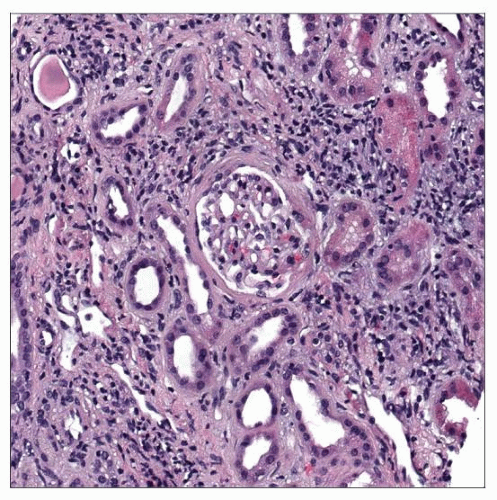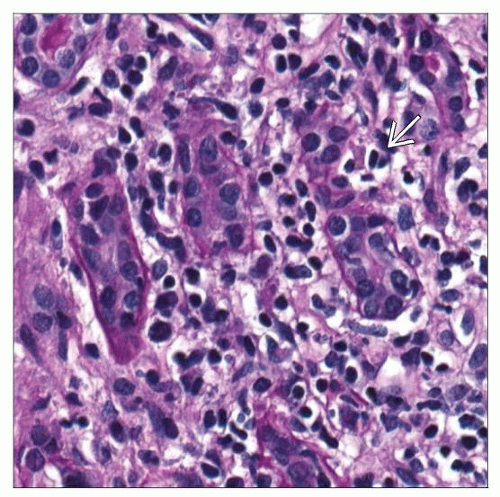Tubulointerstitial Nephritis with Uveitis
A. Brad Farris, III, MD
Key Facts
Terminology
Tubulointerstitial nephritis with uveitis (TINU)
Etiology/Pathogenesis
Autoimmune, infectious, environmental, and genetic
Most likely cause in most cases is autoimmune
Clinical Issues
Mostly children
Females affected more than males
Uveitis and other eye abnormalities
Renal dysfunction: Proteinuria & Fanconi syndrome
Multitude of signs/symptoms (e.g., fever, weight loss, anorexia)
Laboratory abnormalities such as anemia, increased creatinine, increased ESR, proteinuria, urinary leukocytes, normoglycemic glucosuria, hematuria
Spontaneous remission can occur but recovery is usually facilitated with steroids
Permanent renal dysfunction may persist
Microscopic Pathology
Tubulointerstitial nephritis with mononuclear cells (lymphocytes and macrophages), plasma cells, eosinophils, and neutrophils
Acute tubular injury
Noncaseating granulomata in kidneys, bone marrow, and lymph nodes
Top Differential Diagnoses
Drug-induced acute interstitial nephritis
Sarcoidosis
Sjögren syndrome
 Hematoxylin & eosin shows a diffuse interstitial infiltrate with interstitial fibrosis and tubular atrophy in a case of tubulointerstitial nephritis with uveitis (TINU). |
TERMINOLOGY
Abbreviations
Tubulointerstitial nephritis with uveitis (TINU)
Synonyms
Dobrin syndrome
Definitions
Tubulointerstitial nephritis associated with uveitis and, in some cases, identifiable bone marrow granulomas
ETIOLOGY/PATHOGENESIS
Environmental Exposure
Environmental exposures such as insect bites have been proposed in selected cases
Infectious Agents
A few of the multiple suggested associated pathogens include: Klebsiella, Chlamydia, Mycoplasma, herpes zoster, Epstein-Barr virus (EBV), and Toxoplasma
Autoimmune
Most likely cause in most cases
Lymphocyte reactions and circulating antibodies to renal tubular epithelia
Antibodies may also be directed against uveal cells
Genetic
Reports of identical twins and siblings with identical haplotypes suggest genetic predisposition
CLINICAL ISSUES
Epidemiology
Incidence
˜ 5% of lymphocytic interstitial nephritis cases
Age
Mostly adolescents
Median age of onset 15 years; range: 9-74 years
First 2 patients were Caucasian females, 14 and 17 years old, respectively (Dobrin, 1975)
Gender
F > M
Presentation
Eye abnormalities: Anterior uveitis (by definition in all and usually bilateral) and eye pain or redness (32%)
Renal dysfunction: Proteinuria and sometimes a form of Fanconi syndrome (proximal tubule dysfunction)
Stay updated, free articles. Join our Telegram channel

Full access? Get Clinical Tree




